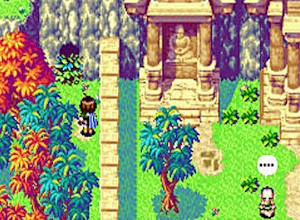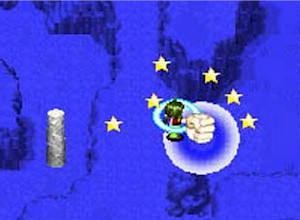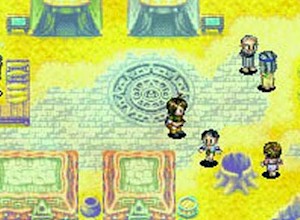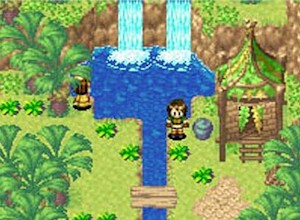Golden Sun: The Lost Age Game Boy Advance Review
After the successful lighting of the first two lighthouses, Felix, Jenna and Kraden begin their quest to find the remaining two elemental lighthouses. Stranded in the Eastern corner of the world of Weyard, the three must search for a way to reach the Great Western Sea. The fate of the world, as always, rests in their hands. And so begins The Lost Age.
The game drops the player right in the thick of the action assuming that they have travelled the quests of the original Golden Sun. Jenna and Kraden are led to the base of Venus Lighthouse as it is about to be lit by Saturos and Minardi. The story leads on from this moment, filled with elements of trust, friendship, companionship, and loyalty. The storyline is a direct follow up to Golden Sun, and so, numerous times along the perilous quest, people that your party meet will detail experiences with Isaac and his party, events that occurred in the past, as well as your own quest being directly influenced by the outcomes of events in the original.
The whole structure of this storytelling is delivered in such a personal tone that the gamer feels like they are a part of the quest and not just directing the characters through it. As a result, you are able to come up with answers for puzzles and trivial matters by intuition rather than having no idea of the activities taking place and what they are for. This is an important and integral part of the gameplay, and although this too has had a few tweaks made, is just as exceptional and enjoying as the very first adventure.
As a result, The Lost Age plays in a very similar way to Golden Sun. Controls are all the same, elements are the same, as are most items. But of course, with a new title, there are various additions that can be made to enhance the experience to be had by the gamer. Camelot has added new weapons, new battle techniques, and even new capabilities to learn. Then, there is also the case of the elemental Djinni.
Once again, characters are aided by the elemental Djinni, along with the tremendous power of their summons. During the Djinni’s resting period, characters can call forth the amazing and absolutely stunning psynergetical powers of the Adepts. These techniques in battle are an essential skill that are required for characters to progress to new areas, follow through with side quests and tasks while building the stats that they require to overcome the ultimate of obstacles in their paths, and return Alchemy to the world once again. There are many more Djinni to collect along with their new techniques to master.
With new areas to explore, dungeons to uncover, and weaponry to collect, there is more than double the play worth of Golden Sun. What’s better is that you can transfer data from the original such as Djinni, weapons, stats, coins, items and progress, which all come to your aid in the final hour.
To compliment the structure of the gaming dynamics of The Lost Age, a large amount of character emotion and exploits have been utilised to pour life all over the cast, including NPCs, not just the main cast. People can be overcome with rage or hate, while others can feel depressed. However, for the majority of the adventure, our heroes maintain an optimistic approach to their responsibility. Each character is filled with personality and attitude. This technique of bringing life to characters with mannerisms, animations and personality also brings the adventure at hand to life.
The power of these animations in characters and the world also, are magnified by the exceptional graphics engine of this wonderful title. Shading and rotation effects play a major part, as does the attention to specific detail of backgrounds, villages, cities and countryside areas. Colours are bright and vibrant, while sprite based animations are fluid and smooth. However, the real beauty of Camelot’s work shines in battle.
The gorgeously jaw-dropping pixel effects, mode-7 scaling and stunning visual composition of characters on screen oozes with amazement. Magical creations of psynergetical might, through multi coloured blazes and bright lights, bring the gamer to absolute admiration of the effects – especially on the limiting hardware of the Game Boy Advance. Creatures look fearful and threatening, and battle backgrounds are just as visually impressive as the works of artists within towns. You will spend at least 50% of time battling, so obviously, this is an important section of the title to maintain gamers’ interests. Camelot succeeds, with techniques that will continue to ‘wow’, even after the completion of the title.
But with an adventure, especially an RPG, the experience is not complete without a musical score. Again, The Lost Age is just as epic, if not more so than its predecessor. An overworld theme that resounds of opportunity, optimism, and excitement is prevalent, while the buzzing activities of townsfolk are emphasised by the catchy beats. Conversely, the laid back lifestyles of tired, lazy little villagers are portrayed by soft, slow, sleepy scores. Battles are also the subject of musical perfection. Edgy tunes that have a habit of working themselves into your head can remain there for days due to their effect on your attitude in battle. These themes demonstrate the essence and importance of a musical score to an RPG title, all the while bringing it to life.
The Lost Age is just as captivating as the original Golden Sun, if not better. The adventure will last around forty hours to complete, and will last even more with the multitude of side quests to complete, items to collect, and Djinni to capture. It has a strong, and welcome, sense of familiarity, with traditional enemies, along with its own additions to the mix. Psynergy is more beautiful than ever, as are the magnificent summons utilising the powers of the Djinni. Characters are just as alive as ever, and there are more things to do and see. Absolutely wonderful.




9.3 out of 10